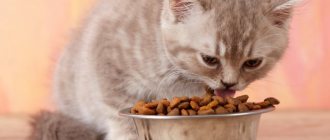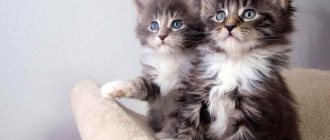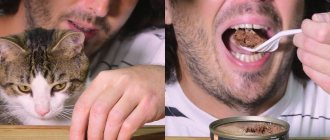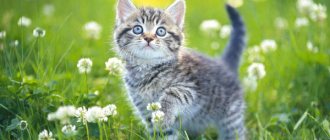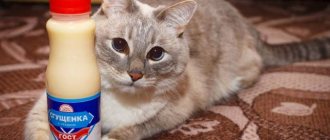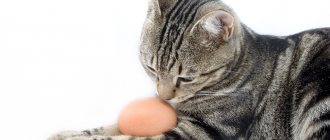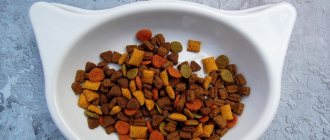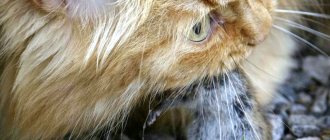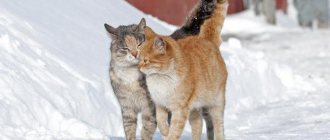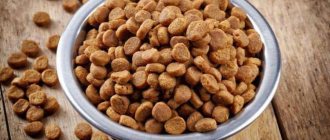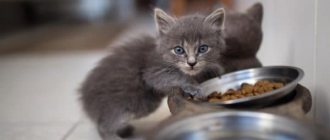Developers of a quality diet calculate the amount of nutrients depending on the weight and activity of the animal. If you give it according to the norms, according to the needs of the body, then everything is fine. If you give less, the animal loses weight, if more, you overload the body with excess calories and nutrients, and this leads to obesity and severe stress on the liver, kidneys and pancreas.
Therefore, it is so important to calculate the required amount of food and not mix the finished diet with other products or give it “as a snack” as an addition to natural feeding.
Dry food introduction period
Before introducing a kitten to dry food, you should think about what age is best to do this.
Veterinarians advise:
- at the age of 1-1.5 months, together with the cat’s mother’s milk, or its substitute;
- over 2.5-3 months of age, when the digestive system is ready to process dry food pellets.
If you offer dry food to kittens that are bottle-fed and have not reached the age of 2.5 months, the development of the digestive organs will go wrong, resulting in a reduction in the animal’s life expectancy. Older kittens can be given dry food without worry.
It is not possible to buy the same dry food
This explanation is one of the most common. Owners buy different foods because the range at the nearest pet store is limited and unstable. As a rule, we are not talking about mixing, but about alternating products. What is the danger of such disorderly feeding?
If the food differs significantly in composition, you risk causing a digestive disorder in your cat, which can manifest itself in different ways, and sometimes be completely asymptomatic. When your pet vomits or has diarrhea, it immediately becomes clear that something has gone wrong. But sometimes the problem is not so obvious: mild stool upset and bloating often go unnoticed, but still cause discomfort to the animal and affect the absorption of nutrients, which over time leads to deficiencies of certain elements in the body.
If you are feeding your cat different dry foods, then it is advisable to choose products of equal composition, ideally products from the same line. And the issue of availability of goods today is easily resolved thanks to online trading. For example, Acana and Orijen foods can be ordered from the online stores listed on this page.
Where to start on the road to dry food?
As practice shows, about 35% of kittens independently switch to dry food, provided they have free access to clean drinking water, because there is no liquid in the food! This means that there are no special problems.
However, the remaining 65% of kittens flatly refuse the proposed menu. In this case, you should slowly accustom your pet to the desired diet according to a certain scheme. If you follow simple rules, the transition process takes 15 days.
Begin to introduce dry granules gradually, with a few pieces added to the food:
- children's meat pates are mixed with several food granules;
- dry food is diluted with baby milk formula;
- The kitten is delayed from serving the portion for 1-1.5 hours, and then first offered dry food, and only then the usual food.
This start will allow the kitten to become familiar with new food and appreciate its benefits. The main thing here is not to shout or force the kitten, otherwise instead of quick training you will get big problems.
Principles of natural food feeding
When organizing natural feeding of a cat, the main task of the owner is to create a diet as close as possible to the “menu” of the pet in nature. Unlike relatively omnivorous dogs, cats are obligate (obligate) carnivores. They feed on the carcasses of small rodents and birds, obtaining from them all the necessary nutritional elements. They eat several times a day, in small portions. The digestive system of representatives of the cat family is adjusted to this method and type of nutrition.
Meat main component
They are characterized by a protein-fat type of metabolism. The enzymes necessary for the breakdown of carbohydrates in the gastrointestinal tract of predators are not synthesized, therefore, carbohydrates are not absorbed. They are needed in small quantities for normal bowel function.
At home, it is almost impossible to accurately recreate the natural feeding of pets. It is difficult to imagine an owner who would agree to release laboratory mice or birds into the apartment so that the cat could hunt them as needed. Conscientious owners try to artificially bring the cat’s nutrition closer to the ideal.
The first thing you need to decide is how to eat. There are three options:
- Free access;
- serving size limitation;
- time mode.
They all have pros and cons. Feeding with a certain frequency, at a constant time, helps control the amount of food consumed, stabilizes the functioning of the digestive system, and helps prevent obesity.
Free access to food is closer to the cat's natural diet. She can control her “reserves” and feels and behaves more calmly. At the same time, the owner may not immediately notice problems with the cat’s appetite or overeating when feeding this way. This type of meal arrangement is especially dangerous when there are several cats living in the house. The free access method is not suitable for individuals who lack a sense of proportion. There are quite a lot of such cats; they eat the entire portion at once, no matter how large it is, and then quickly gain excess weight.
Toyger cats, description, history of the breed, photos and price in rubles for kittens
Pets with such eating habits should be given a limited amount of low-calorie, fiber-enriched food. If there is no possibility of constant control, it is better to feed the cat according to the schedule.
Clean water should always be available. Cats are desert animals and have less need for fluid, but it is necessary for normal kidney function.
How to move forward to dehydrated food?
If a start has been made and the kitten has begun to eat dry food, it is worth putting dry food granules in a bowl between feedings. The main thing is, do not forget to add clean water to the drinking bowl in time, because the cat’s body will have to spend a lot of water to soften the food granules.
Standard scheme for accustoming to a new diet in 15 days: on the first day, you add about 1/10 of the dry granules to the food you were used to at that time, gradually increasing the proportion of dry food to 100% on the 15th day. If at any stage the process freezes, reduce the concentration to the previous one and switch to a smoother pace.
Important:
- calculate the serving size according to the weight and age of the kitten;
- Always keep a bowl of clean water next to the food;
- Give only fresh food, without mixing it with leftover food in the bowl.
Rules for feeding dry granules to 3-month-old kittens
Despite all the benefits of dry industrial food, their presence on the menu as the only and main food product can cause undesirable consequences, especially if you feed your pet with them incorrectly. There are a number of recommendations that must be followed without fail:
- Exact compliance with the daily norm . How much food a kitten needs per day depends on its weight, breed characteristics and the type of product chosen. It is easy to determine the norm - you need to study the information on the packaging. Each manufacturer gives its own daily recommendations, depending on the ingredients in the composition and the concentration of nutrients. Failure to follow recommendations may result in overfeeding and overdose of vitamins.
- The daily amount of feed specified by the manufacturer should be divided into equal parts . The frequency of feeding a kitten at the age of 3 months is up to 5 times. It is not recommended to leave food in the bowl. After feeding, it must be removed so that the kitten begins to develop a feeding routine. Food should also be removed for the reason that at 3 months the kitten still has poor control over its satiety and can eat everything that is left for it.
- Compliance with drinking regime . Dry food contains a minimal amount of moisture. If the kitten's diet consists exclusively of industrial food, you need to teach the baby to drink enough water.
To give or not to give “adult” food.
Giving a kitten food intended for adult animals is strictly prohibited.
The difference lies in the amount of vitamins and the balance of nutrients. In “adult” food, the concentration will be much higher, and the kitten, in addition to indigestion, may experience hypervitaminosis.
Other differences between food for kittens and the “adult” product:
- An adult cat is no longer growing, so it does not need as many “energy” components; accordingly, the fat and protein content in the food is less. An actively growing kitten needs more protein. If the pet does not receive it in sufficient quantities, this will affect its overall well-being and development.
- Granule size. Food for adult cats is available in the form of large granules. A small kitten whose teeth have not yet strengthened is simply not capable of chewing such large pieces. Swallowing the pellets whole, kittens often choke on them. Kitten products are typically made in small kibble sizes designed for the delicate teeth of small animals.
You should choose dry food for your kitten only according to the age indicated on the package.
Typical mistakes in introducing dry food
For some reason, many kitten owners are sure that there is no need to accustom their pet, and that the kitten itself must guess that the food offered is nothing more than its breakfast, lunch or dinner. Most likely, such owners are guided by the principle “if you want, you can eat whatever.”
However, this is a bad strategy. Firstly, it is ineffective, and secondly, a kitten with its sensitive digestion and weak immunity will easily develop serious health problems, which the owner will have to solve.
That's why:
- You should never punish a kitten for refusing dry food;
- It is prohibited to force an animal to dry food;
- You cannot speed up the process at will.
Is it possible to feed dry food and natural food at the same time?
A varied diet is important for cats ; this does not mean that a small predator needs delicacies. Under natural conditions, representatives of the cat family eat certain foods throughout their lives. The main thing is that food serves as a source of nutrients in the right proportion.
A pet cannot choose its own food ; the owner must decide what type of food is suitable for the animal. Dry pads are preferable to food from a person's table. But natural products (meat, milk, fish, vegetables), prepared taking into account the cat’s needs, will bring tangible benefits to the body.
Doctors do not recommend feeding industrial food and natural food at the same time. A mixed type of feeding will lead to imbalance, indigestion, gastritis, and colitis. The animal's metabolism will be disrupted.
Possible problems when accustoming a kitten to dry food
In some cases, kitten owners are faced with a situation where a pet that has begun to actively get accustomed to dry food suddenly refuses to eat. This may be due to a lack of clean water in the drinking bowl. As already mentioned, with a dry diet, the kitten should have unlimited access to drink, since a large amount of moisture is spent on softening the granules.
The second problem that prevents you from accustoming a young cat to dry food may be mixing old and new portions of food. The food left over from the previous meal acquires an unpleasant smell for the kitten, so he refuses it.
To prevent this from happening, you should:
- correctly calculate the serving volume;
- wash the cat's bowl after feeding;
- offer other “meals”, including cat treats, in a separate bowl.
The third problem is improper storage of feed. Factory packaging that does not have special fastenings is not suitable for this after opening in principle, since the food can deteriorate and the aroma is lost.
And food that does not smell is no longer food for a kitten. The solution here is a special container with a tight lid for storing food, which can be bought in any household goods department.
Basic rules for switching a cat to another food
You can, of course, immediately give the animal new food, in 90% of cases the cat will simply refuse the new food, and this can also lead to an upset stomach and vomiting. So how can you correctly switch a cat to another food so as not to injure the animal or cause damage to the pet’s gastrointestinal tract? To prevent the animal from noticing a sudden change in diet, you need to add new food to the cat’s usual food in small portions for 10 days. This way you can check if your cat is allergic to a new food. If the animal has responded well to the new food and eats it with pleasure along with the old one, then you can gradually, by adding new food in small portions, remove the old food from the diet. On average, such a transfer is completed in 3-4 weeks. If the cat tolerates the new product well, the transfer time can be reduced to 2 weeks.
If for some reason your pet refuses new food, leaving it in the bowl, there is another way to switch your cat to another food, but it may seem very inhumane, although it is very effective. The essence of the method is to temporarily put the cat on a starvation diet. Having refused a portion of new food, the cat expects that he will now be fed his usual food, but nothing happens. After walking around looking unhappy, the hungry cat again approaches the bowl. After several such approaches, the cat eats the remains of the new food. The next day, we again dilute the favorite food with new food and do not give anything else until the bowl is empty. This diet is acceptable for 3-4 days. But if the pet continues to refuse new food, you should contact your veterinarian and ask how to switch the cat from one food to another, otherwise the animal may begin to develop a dangerous liver disease, which is fatal.
When switching an animal from natural food to dry food, or vice versa, you can give the cat prebiotics. They will help the gastrointestinal tract adapt to new food faster.
There are times when a sudden change is necessary, for example, when switching an animal to medicinal food, when an intolerance to components of the usual menu appears, or when there is a food allergy. In this case, there is a little trick on how to switch a cat to another dry food, which is to lightly pour fish broth over the dry food. This will attract the animal's attention. Do not forget to constantly monitor the condition of your pet, its behavior, appearance, so that there are no negative reactions. If any symptoms appear, contact your veterinarian immediately. A timely visit to a specialist will help preserve the life and health of your pet.
Which food to choose?
The correct choice of dry food determines whether the baby will get used to the new diet and how the change in menu will affect his health. Veterinarians advise buying food that is produced specifically for kittens. Moreover, it will be easier to accustom cats to a new menu with them.
Almost any brand's product line includes specialized dry food for kittens. It is important to choose a super premium or holistic food that meets the needs of the carnivorous animals that are cats.
Monitor your pet's reaction
When introducing a kitten to dry food, carefully monitor what is happening. If the baby is cheerful and active, gains weight well, and his gastrointestinal tract works like a clock, then the diet has been chosen correctly.
If your pet has loose stools or constipation, allergy symptoms (itching, rash, hair loss), you need to pause the transition to a new diet and seek advice from a veterinarian.
Sources:
https://murkosha.ru/nashi-stati/soderzhanie-i-ukhod/kak-priuchit-kotenka-k-sukhomu-kormu
https://www.acana.ru/kak-priuchit-kotyonka-k-suhomu-kormu
